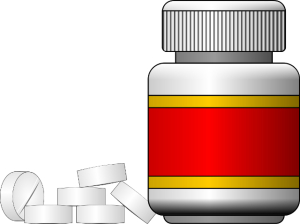Before there was medicine, there was “wilderness medicine”…
– Buck Tilton, Wilderness First Responder: How to Recognize, Treat, and Prevent Emergencies in the Backcountry, Globe Pequot, 2004
Ancient Asprin Discovered in 1,300-Year-Old-Pot
I took a break from my studies to do a little Internet surfing. I stumbled upon an article detailing how archeologists discovered traces of ancient aspirin in shards of Native American pottery. They found the shards underneath a rock outcrop in Colorado. The pottery is thought to be more than 1,300 years old.
Here is the article:
1,300-Year-Old Pottery Found in Colorado Contains Ancient ‘Natural Aspirin’
The traces of salicylic acid could have come from the inner bark (cambium layer) of willow (Salix sp.). Salicylic acid is the natural precursor of our manufactured aspirin (acetylsalicylic acid). In fact, most of the compounds we use in medicine today were originally discovered in nature. This is one of the most persuasive (and self-serving) arguments for preserving the biodiversity of our planet.

Pain Relief from Ancient History
 Man has used willow bark throughout history to treat a variety of ailments. Its recorded use dates back to the time of Hippocrates (400 BC). Patients were advised to chew the bark to relieve pain and fever.
Man has used willow bark throughout history to treat a variety of ailments. Its recorded use dates back to the time of Hippocrates (400 BC). Patients were advised to chew the bark to relieve pain and fever.
Willow bark can be effective for pain relief, reducing inflammation, and controlling fever. Used sparingly, it is relatively safe. But it shares the same side effects as other NSAIDs. This can include upset stomach, nausea, vomiting, and stomach bleeding.
Modern aspirin was formulated to reduce stomach bleeding associated with salicylic acid, when it was concentrated into a pharmaceutical. Ironically, the natural salicin we get from willow bark is actually less irritating to your stomach than synthetic aspirin1. But it is not as potent as the synthetic product.
Salicylic acid is also a blood thinning agent and can affect clotting. Like other NSAIDs, overdose can cause kidney damage.
How it Works
Both natural and synthetic aspirins reduce the levels of prostaglandins in the body. Prostaglandins are found in almost every tissue in our bodies. These hormone-like chemicals help amplify the “pain” signals that nerves send to the brain. They also control inflammation that can lead to pain.
Try It Yourself

Try this experiment: Find a species of willow and chew a leaf. Be sure to identify the tree correctly! You will experience the same bitter, chalky, astringent taste you get from chewing aspirin tablets. It is not a pleasant taste! Spit out the leaf after you taste it.
I always carry a well-stocked first aid kit with a variety of pain relievers. They have been clinically tested and found safe and effective. Their dose has been carefully calibrated. These would be my first choice if I was in pain far from home.
But it is nice to know that nature’s pharmacy can help us treat pain, inflammation, and fever. Should I have need of a field-expedient analgesic, I would strip the cambium bark and chew it, or steep it in warm water to create a tea.
Harvesting a small amount from a tree should do no harm. But do not harvest from the same tree more than once per year. You must also be careful not to girdle the tree. This will kill it! Take only what you need and allow the tree to thrive. This benefits the ecology and you can use the tree again as a resource in the future.
You need only a small amount to make tea. This dosage guideline comes from the University of Maryland Medical Center:
- Dried herb (used to make tea): boil 1 – 2 tsp of dried bark in 8 oz of water and simmer for 10 – 15 minutes; let steep for ½ hour; drink 3 – 4 cups daily.
Again, I would use willow bark as a field-expedient analgesic only in an emergency. Be sure to consult the references below for a complete list of potential side effects and drug interactions.
Have you ever used wild medicinal plants? Share your experience in the comments below.
A chemist walks into a pharmacy and asks the pharmacist, “Do you have any acetylsalicylic acid?”
“You mean aspirin?” asked the pharmacist.
“That’s it, I can never remember that word!” 😀
References
University of Maryland Medical Center
1. Herbs for Health and Healing, Kathi Keville with Peter Korn
Related Posts on NatureOutside
Archaeology, Technology, and Native Peoples
If you enjoyed learning about ancient aspirin, you may like other posts in the Skills Section.


Leave a Comment